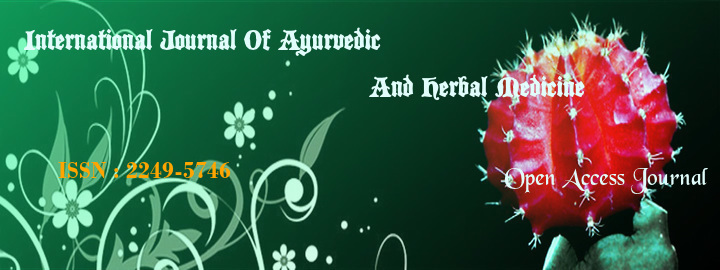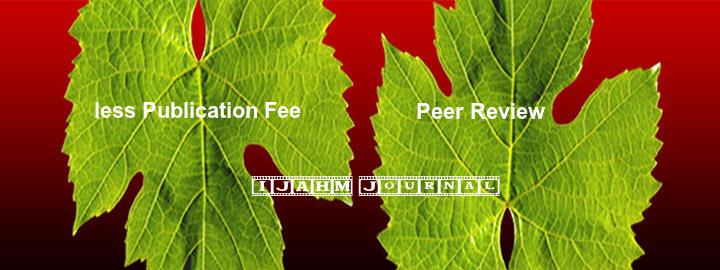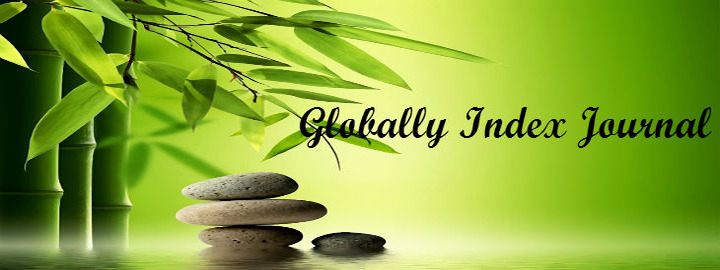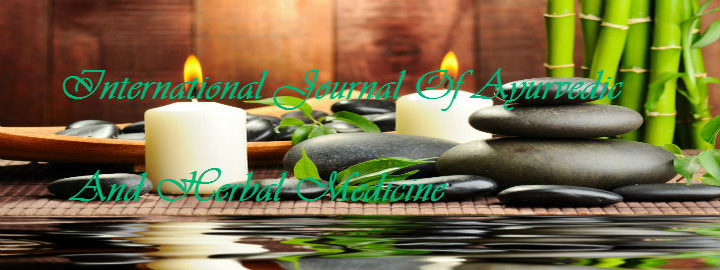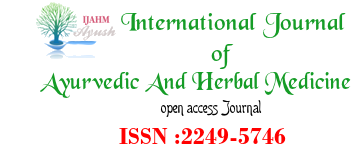


Volume 3 Issue 5 [September-October 2013]
Authors : Suresh Kumar*1, Gian Chand1 and Parveen Sankhyan2
Abstract : Traditional systems of medicine have formed the basis of health care throughout the world since the earliest days of humanity and still continue to be widely practiced globally. The Himalayas have a great wealth of traditional medicinal knowledge. Himachal Pradesh, one of the pioneer Himalayan States is a rich repository of medicinal flora. The climatic conditions prevailing in the region maintains an ideal habitat for the natural growth of variety of medicinal plants and herbs. These are the sources which provide raw materials for pharmaceutical, phytochemical and cosmetic industries. Therefore, the present study aims at exploring and documenting the plants used for curing different diseases by different communities of Lug Valley, Distt. Kullu, Himachal Pradesh.
Title : VIRECHANA (PURGATION THERAPY) – A REVIEW
Author : Dr. Chaudhari Manojkumar V.
Abstract : Charaka Samhita is superior text of Chikitsa, which needs a polish just to prove its significance and utmost importance in today’s context, in order to earn perfection in Ayurvedic Chikitsa. Charaka has elaborately described the use of Panchakarma in different diseases. Also Charaka has described Vamana, Virechana, Anuvasana Basti, Aasthapana Basti and Shirovirechana as the Panchakarma. He has not included Raktamokshan in Panchakarma.Charaka Samhita seems to be dealing with holistic approach in Panchkarma. In Charak Samhita all the Karma are described in detail. Charaka has almost covered all the aspects of particular Karma. He has given extensive lists of indications and contraindications in all the Karma. Also Samyak Yoga, Atiyoga, Ayoga symptoms are very extensively explained by Charaka. There are very few exceptions found in Sushruta and Vagbhata as compared to Charaka. These symptoms should be considered as contributory factors of Sushruta and Vagbhata.Chronologically Sushruta and Vagbhata are after Charak Samhita. Hence accordingly there are certain changes observed in these two Samhita. Sushruta is Shalya Pradhana Samhita. Hence there are certain indications which are elaborately described by Sushruta Samhita. Due to shalya pradhanta he added the Raktamokshana in Samshodhana chikitsa. Ashtang Hridya is considered as critical edition of Charaka and Sushruta. Hence Vagbhata has given combinatory symptoms from Charaka and Sushruta. Also certain symptoms are contributory from Vagbhata. In short, it has found that Charaka has given all the aspects of Karma in detail. The additional symptoms given by Sushruta and Vagbhata can be included in aspects described by Charaka. Hence it is utmost important to study Charak Samhita thoroughly using lights of Sushruta Samhita and Ashtang Hridya. It is found that there is definite and positive co-relationship between concepts of Panchakarma in Bhrihattrayee. But there are some additional symptoms are also given by Sushruta and Vagbhata. So while preceding the Panchakarma we must follow the Charaka Samhita in the illumination of Sushruta Samhita and Ashtang Hridaya
Title : WITHANIA COAGULANS DUNAL. (PANEER DODA): A REVIEW
Authors : Vandana Gupta1, Bipin Bihari Keshari2
Abstract : plant based medicines have created much awareness in the today’s society due to their various well proven therapeutic effects and lack of side effects which has provoked the human to go back towards nature for safer herbal remedies. The plant, Withania coagulans Dunal is one of them which is used to cure various ailments and used in folk medicine. Withania coagulans Dunal commonly known as Indian cheese maker has been used for preparing a vegetable rennet ferment for making cheese in different parts of India. Different parts of this plant have been reported to possess a variety of biological activities. In Nothern India traditional healers use dry fruits of Withania coagulans for the treatment of diabetic patients. Withania coagulans Dunal. has been shown to exert hypoglycemic, hypolipidemic, free radical scavanging, cardiovascular, central nervous system depressant, hepatoprotective, anti-inflamatory, wound healing, antitumor, immuno-suppressive, cytotoxic, antifungal and antibacterial properties. The twigs are chewed for cleaning of teeth and the smokes of the plant is inhaled for relief in toothache. A large numbers of phytochemicals have been isolated from Withania coagulans which are responsible for various pharmacological action of this plant. The present article aims in projecting a detailed review of the plant regarding its morphology, chemical constituents and pharmacological properties. It has also included therapeutic effects of the whole plant and its extracts and isolated withanolides
Title : TGROWTH AND DEVELOPMENT IN CHILDREN: AN AYURVEDIC PERSPECTIVE
Authors : *1Arun Raj GR, 2Shailaja U, 3Rao Prasanna N
Abstract : Growth is an essential feature of life of a child that distinguishes him or her from an adult. The process of growth starts from the time of conception and continues until the child grows into a fully mature adult.Development refers to qualitative and quantitative changes and acquisition of a variety of competencies for functioning optimally in a social milieu. Further development is a continuous process from birth to maturity.. It may be stressed that, besides 10% prevalence of developmental delay, the early identification of such problems remains difficult.There are different factors explained in Ayurvedic classics which are going for the maintenance and promotion of growth and development in children. This paper throws light on all those concepts aiding in a positive build-up of child’s growth and development. Keywords: growth, development, developmental delay
Title :To study the action of Basella alba ethanolic extract on Calcium Oxalate in vitro.
Authors : Sudhir Sase* 1, R . P. Limaye 2, Navneet Soni 3,Sudin Gaikwad4 [/tcontent]
[tcontent class="" id="dws_tab13821229596241"]Basella alba plant is used for the treatment of the diseases as well as different healing activities of human beings.Basell alba is cool season ,vegetable and widely cultivated. It is also called as Malabar Climbing ,Puli Shak. Fresh leaves are commonly chewed for treatment of Kidney stone treatment around this area. The aim of study was to evaluate role of B.alba extraction on dissolving capacity of calcium oxalate crystals. Leaves extracts shows admirable dissolving capacity of crystals in vitro.[/tcontent]
[tcontent class="" id="dws_tab13821229853861"]Click Here Download PDF[/tcontent]
[/tcontents]
[/tabs]
[tabs]
[thead]
[tab class="active" type="tab" href="#dws_first_tab78" title="Citation"]
[tab class="" type="tab" href="#dws_tab138212309547478" title="Abstract"]
[tab class="" type="tab" href="#dws_tab138212312071878" title="Download PDF"]
[/thead][tcontents]
[tcontent class="active" id="dws_first_tab78"]Title : A SURVEY OF TRADITIONAL MEDICINAL PLANTS FROM THE VELLORE DISTRICT, TAMILNADU, INDIA.
Authors : Sundaresan S and Senthilkumar B*
Abstract : Man has always made use of medicinal plants to cure sufferings and diseases. This review is not documented information of the various therapeutic applications of plants used in traditional medicine. The rural folk and old aged people have long been using plants for their various ailments. However this information related to traditional medicinal uses of plants is not well documented. There is an urgent need for documenting these folklore and traditional knowledge in some form before such valuable knowledge becomes inaccessible and extinct. A botanical survey was carried out among the various species of medicinal plants in Vellore district, Tamilnadu, India. Traditional uses of 124 plant species belonging to 40 families are described for their medicinal properties in the present study. The tribal people use these plants to treat skin allergy, dysentery, for anti-bacterial activity, diabetes, jaundice, asthma, fertility, antifertility, dental diseases, etc. The medicinal plants used by them are arranged alphabetically followed by family name, local name and their medicinal uses.
Authors : *Dr. L. D. Barik **Dr.S.P .Mishra ***Prof.U.S.Dwivedi ** **Prof. M. Sahu
Abstract
Encrustation, a crust or hard coating on the surface of urinary stent, is developed due to the formation of biofilm further leads to blockage of Urinary catheters and increases renal pressure and ultimately damage renal parenchyma tissues. Material & Methods- 40 albino rats procured from Central animal house of and kept at Centre of Experimental Medicine and Surgery Department of Banaras Hindu University, Varanasi. They were grouped into control, preventive and treatment. All Albino rats were intervened with the implantation of Urinary catheters bead in the urinary bladder following Suprapubic cystostomy under intraperitoneally injected pentobarbitone sodium in a dose of 30-60 mg /kg body weight. Drug schedules-One Ayurvedic drug(taking equal quantity of Bryophyllum pinnatum and Crataeva nurvala quath extract) was given in a dose of 35 mg/100 gm body weight to Preventive group(7 days before and 30 days after implantation) and 30 days to Treatment group. Study period was of two months and Urine out, Urine pH , Plasma electrolytes and Urinary electrolytes were evaluated in a period of 15 days interval and also plain x-ray abdomen done in all the group. Discussion & Result -statistical p-value shows significant in increasing Urine output & Serum Potassium in both Preventive and Treatment group where as Urine pH was remarkably decreased to normal 5.5 to 6.5. Serum Calcium, Serum Sodium& Urinary sodium were also shown remarkably decreased .p value was also shown highly significant in both the group in comparison to control group in reducing the catheter encrustation. Serum Uric acid and Serum phosphorus were within their normal limit in the entire group.
Title : Tridax pombens: A source for antimicrobial activity
Authors : Priyadarshini. D. S and Priya Iyer
Abstract : Tridax Proumbens is a species following plant in the daisy family. Its common names include coat buttons and Tridax daisy. Callus and suspension culture was obtained using different explants.The different solvent extracts of Tridax plant and callus was checked for antimicrobial activity against Escherchia coli, Staphylococcus aureus, Pseudomonas aerogenosa, Aspergillus niger and Penicillium chrysogenum. The plant was also tested for the presence of different phytochemicals.
Title : Stress can impact of sexual life; How to overcome Ayurveda
Author : Dr. Balaji Deekshitulu P.V,
Abstract : Ayurvedic systems of medicine are over 5000 years old. The concept of Stress can impact of sexual life. Ayurveda is guided and reduce the stress. Ayurveda is highlighted as a holistic system with its concern for prevention and promotion of stress and sexual health. Key Words: Stress, sexual problems, effect of Ayurveda.
Faujdar S.*, Gauttam V., Kalia A.N.
2. Importance Of Diet And Methods Of Its Ingestion
Dr.Shweta Musale1 Dr. Vipan Saraswat2 Dr. Mohan Lal Jaiswal3 Dr. sumit nathani4 Gaurav Sharma5
Dr.Sanjeev.S.Tonni
T.Purushoth Prabhu1, S. Selva kumari2, W.Clement Atlee3, R.Vijayakumar4, R.Suresh5
martins emeje, Frank Ohwoavworhua, Christiana Isimi, Olobayo Kunle
6. Hypoglycaemic Activity Of Cedrela Toona Roxb. Leaves In Alloxan – Induced Diabetic Rats.
Shah Kinjal H1*, Dr. Patel Piyush M2
7. Antipyretic activity of Chloroform extracts of Geniosporum prostratum (L) Benth.
Gaurav Sharma1, Dr. Lalit Nagar2, Dr. Ashashri Shinde3, Dr. Sudipt Rath4, Dr. Naresh Khemani5
8. A Comprehensive Review On Theories Of Aging
Dr. Arvind Kumar Gupta1Dr. Sangeeta S. Mishra2 Dr. Kedar Lal Meena3
9. Effect Of Agnihotra (Sacred Fire) On Microbial Growth.
Dr. Mrs. Purandare VR, Dr. Mrs. Prasad NB
Prema Chandra Sekhar 1 , Y. Vijay Kumar 2 J.Ratna Grace 3, O.Aniel kumar 4 And P. Prayaga Murty
11. Survey of wall flora in Ginger fort and uncared gopuras in Gingee taluk, villupuram district
S.Rajalakshmi, Dr. K . Shanthi.
12. Studies on Seed Biology of Cinnamomum tamala Nees (Lauraceae): A Valuable Multipurpose Tree’
Madhabi S. Deb, N. S. Jamir , Chitta Ranjan Deb*
13. Amla – The Wonder Of Ayurvedic Medicine
M.Mohanapriya*, Lalitha Ramaswamy**
14. Hepatoprotection Through Ayurvedic Herbs
SinghKaram1 and Verma Bhavna 2
Jayanthi, P., Aravindhan, V. and Rajendran, A.*
16. “Role Of Virechana In Asrigdara”
*1Dr.Seema Murthy, 2 Dr.Siddaram Arawatti, 3 Dr.Manjunatha T.S., 4 Dr.S.Bhatted 5Dr.L.V.Ratnakar
Satyam Tripathi, Nagarathna Raghuram, Nagendra Hongasandra Ramarao
18. A SHORT REVIEW ON HOW PESTICIDES AFFECT HUMAN HEALTH
1Meenakshi, 2Prabhakar Sharon ,3Mittal Bhawana, 3Sharma Anita ,4Gothecha V.K.
index







